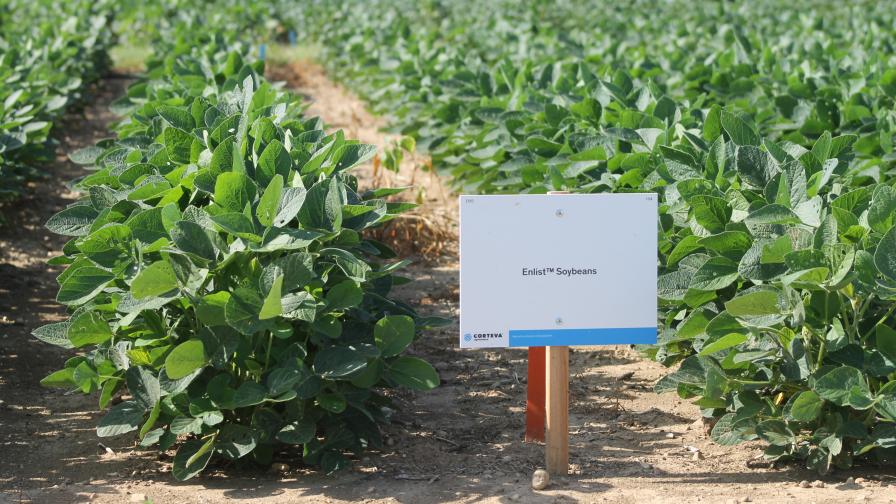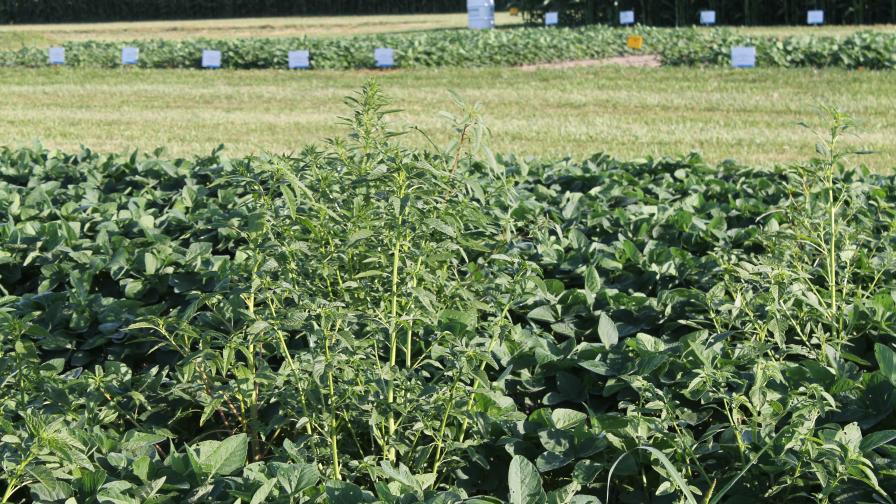Corteva Field Day Addresses Lingering Issues

Enlist soybeans were on display at the first-ever Corteva Field Day at the company’s research farm in Sheridan, IN.
For several summers now, ag journalists have had the chance to learn about market trends at the annual Dow Field Day, usually held in Indiana not too far from the company’s headquarters in Indianapolis. In 2018, however, with the merger of Dow and DuPont Crop Protection complete, visitors were instead invited to the first-ever Corteva Field Day at the company’s research farm in Sheridan, IN.
“I’m happy to welcome all of you to the first field day using the Corteva name,” Andy Fordice, Category Leader, said. “But even with a new name, we still are dealing with challenging times for agriculture, with commodity prices where they currently are.” Fordice noted several other key challenges facing the agricultural marketplace in 2018, including many that were subsequently addressed by other Corteva representatives.
Perhaps most top of mind among these is crop disease. According to Dr. Mike Meyer, Disease Management Technical Expert, this is a direct result of what kind of weather conditions have dominated 2018 thus far. “This year has been an excellent year for disease development,” Meyer said. “Places such as Wisconsin and Minnesota had a lot of white mold in their fields a lot earlier than normal.”
Meyer went on to describe disease management as a “proactive, not reactive” exercise for growers. And to aid in this approach, Corteva offers Aproach Prima fungicide (picoxystrobin methyl+cyproconazole) for corn and soybean disease control. “An application of Aproach Prima at tasseling helps protect the ear leaf and upper one-third of the corn canopy during the grain fill period,” he said. “For soybeans, an application around the R3 growth stage, ahead of pod fill, typically provides the greatest return on investment.”
In addition, Meyer said, Aproach Prima can aid users in their battles against resistant crop diseases such as frogeye leaf spot. “There are plenty of documented cases of frogeye leaf spot out in the field,” he said. “Because of its active ingredient mix, Aproach Prima can act on different stages of the fungus life cycle.”
Weed Resistance
Of course, when you are talking about resistance in crop fields, weeds tend to get most of the attention. And for good reason, Dave Roome, Customer Technical Specialist, said. “The amaranth species is difficult to control, and waterhemp is probably the most prolific weed across much of the Midwest,” he said. “New cases of resistant waterhemp are daunting to those of us in the ag industry because it threatens the already delicate return on investment ratio.”
Now, he added, researchers have discovered a species of waterhemp in Missouri that has documented resistance to six classes of herbicides, making it a major threat to future corn and soybean yields. “But waterhemp can grow stronger each year,” Roome said. “We have to stay aggressive at reducing waterhemp seedbank to protect fall yield and get a head start on next season.”
To help combat the spread of resistant waterhemp, Roome offered five suggestions for ag retailers and their grower-customers to follow:
- Scout diligently. “Identify waterhemp early and continue to check your fields and during midsummer. Ongoing scouting helps farmers plan timely postemergence herbicide applications and identify potential problem fields for the following year.”
- Layer residual herbicides. “Layering residual herbicides keeps fields clean longer, typically through corn canopy closure, to manage waterhemp seedbank.”
- Plant narrower rows. “Narrow row spacing can help suppress waterhemp growth by allowing crops to reach canopy closure quicker. Tillage can also help lower waterhemp populations because the seeds must germinate in the top part of the soil.”
- Prevent weeds from going to seed. “Just a few waterhemp weeds left in a field can present significant problems for the next season. Waterhemp that goes to seed in corn and soybean fields can potentially cross-pollinate with a population in another field and build additional resistance.”
- Maximize application technology. “Pay close attention to herbicide labels to maximize the efficacy of the product. Not every herbicide can be applied in the same manner with the same nozzles, water volumes, pressures, and adjuvants.”
In addition to these measures, Corteva also has the Enlist cropping system as an option. According to Shawna Hubbard, Herbicides Product Manager, Enlist “is the cornerstone technology for Corteva for weed control.” She added that Enlist cotton was available during the 2018 planting season, and that the company saw “a three-fold increase in acres planted with it compared with 2017.” Enlist soybeans are still awaiting import approvals from key markets such as China, Hubbard said.







